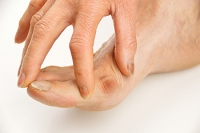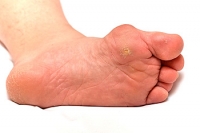
Blog (790)
It’s Time for Beautiful Feet
It's Time for Beautiful Feet
What is a Bunion?
A large growth located on the foot at the bottom of the big toe is referred to as a bunion. It appears as an unsightly bony mass and may be caused by a predisposed inherited trait.
Wearing high heels may cause the toes to remain in a cramped position for extended periods of time, and this can exacerbate an existing bunion. There are several ways to prevent this condition from occurring, including wearing shoes with a low heel or making sure a supportive feature, such as a strap, is present to prevent the foot from sliding. Additionally, it’s important to wear shoes with ample room to allow the toes to move freely. If you’re experiencing a bunion that’s causing severe pain, a consultation with a podiatrist is advised for possible treatment options.
If you are suffering from bunions, contact Dr. Kenneth Donovan of Advanced Care Foot and Ankle. Our doctor can provide the care you need to keep you pain-free and on your feet.
What Is a Bunion?
A bunion is formed of swollen tissue or an enlargement of boney growth, usually located at the base joint of the toe that connects to the foot. The swelling occurs due to the bones in the big toe shifting inward, which impacts the other toes of the foot. This causes the area around the base of the big toe to become inflamed and painful.
Why Do Bunions Form?
Genetics – Susceptibility to bunions are often hereditary
Stress on the feet – Poorly fitted and uncomfortable footwear that places stress on feet, such as heels, can worsen existing bunions
How Are Bunions Diagnosed?
Doctors often perform two tests – blood tests and x-rays – when trying to diagnose bunions, especially in the early stages of development. Blood tests help determine if the foot pain is being caused by something else, such as arthritis, while x-rays provide a clear picture of your bone structure to your doctor.
How Are Bunions Treated?
- Refrain from wearing heels or similar shoes that cause discomfort
- Select wider shoes that can provide more comfort and reduce pain
- Anti-inflammatory and pain management drugs
- Orthotics or foot inserts
- Surgery
If you have any questions, please feel free to contact one of our offices located in Warren, Livingston, and Toms River, NJ. We offer the newest diagnostic and treatment technologies for all your foot care needs.
Symptoms of a Broken Toe
Severe pain is likely to be experienced if you have a broken toe, and it will typically heal within 6 weeks. The toe may be tender, bruised, and swollen, often resulting in difficulty in walking. The treatment for a broken or bruised toe is the same, despite the fact that many people have trouble differentiating between the two. Temporary relief may come from elevating the foot, which generally helps in reducing any pain or swelling associated with this condition. Additionally, choosing to wear shoes that give the toes ample room to move may aid in diminishing any discomfort that may be experienced. If the toe is bent at an unnatural angle indicating a severe break, a consultation with a podiatrist is suggested for ways to properly treat your broken toe.
A broken toe can be very painful and lead to complications if not properly fixed. If you have any concerns about your feet, contact Dr. Kenneth Donovan from Advanced Care Foot and Ankle. Our doctor will treat your foot and ankle needs.
What to Know About a Broken Toe
Although most people try to avoid foot trauma such as banging, stubbing, or dropping heavy objects on their feet, the unfortunate fact is that it is a common occurrence. Given the fact that toes are positioned in front of the feet, they typically sustain the brunt of such trauma. When trauma occurs to a toe, the result can be a painful break (fracture).
Symptoms of a Broken Toe
- Throbbing pain
- Swelling
- Bruising on the skin and toenail
- The inability to move the toe
- Toe appears crooked or disfigured
- Tingling or numbness in the toe
Generally, it is best to stay off of the injured toe with the affected foot elevated.
Severe toe fractures may be treated with a splint, cast, and in some cases, minor surgery. Due to its position and the pressure it endures with daily activity, future complications can occur if the big toe is not properly treated.
If you have any questions please feel free to contact one of our offices located in Warren, Livingston, and Toms River, NJ. We offer the newest diagnostic and treatment technologies for all your foot and ankle needs.
What is Sesamoiditis?
The tendons attached to the bones located on the sole of the foot are referred to as the sesamoid bones. If these tendons become inflamed, typically resulting from an injury, a condition known as sesamoiditis occurs. A common symptom is pain experienced under the ball of the foot while walking, or discomfort may be felt from standing on your toes because the tendons are stretched. Choosing to wear high heels in addition to participating in sports that involve running and jumping may be common causes of this condition. Treatment may include ceasing the activity that caused sesamoiditis and considering a consultation with a podiatrist for custom-made insoles to provide relief.
Sesamoiditis is an unpleasant foot condition characterized by pain in the balls of the feet. If you think you’re struggling with sesamoiditis, contact Dr. Kenneth Donovan of Advanced Care Foot and Ankle. Our doctor will treat your condition thoroughly and effectively.
Sesamoiditis
Sesamoiditis is a condition of the foot that affects the ball of the foot. It is more common in younger people than it is in older people. It can also occur with people who have begun a new exercise program, since their bodies are adjusting to the new physical regimen. Pain may also be caused by the inflammation of tendons surrounding the bones. It is important to seek treatment in its early stages because if you ignore the pain, this condition can lead to more serious problems such as severe irritation and bone fractures.
Causes of Sesamoiditis
- Sudden increase in activity
- Increase in physically strenuous movement without a proper warm up or build up
- Foot structure: those who have smaller, bonier feet or those with a high arch may be more susceptible
Treatment for sesamoiditis is non-invasive and simple. Doctors may recommend a strict rest period where the patient forgoes most physical activity. This will help give the patient time to heal their feet through limited activity. For serious cases, it is best to speak with your doctor to determine a treatment option that will help your specific needs.
If you have any questions please feel free to contact one of our offices located in Warren, Livingston, and Toms River, NJ. We offer the newest diagnostic and treatment technologies for all your foot and ankle needs.
What is Sesamoiditis?
 The tendons attached to the bones located on the sole of the foot are referred to as the sesamoid bones. If these tendons become inflamed, typically resulting from an injury, a condition known as sesamoiditis occurs. A common symptom is pain experienced under the ball of the foot while walking, or discomfort may be felt from standing on your toes because the tendons are stretched. Choosing to wear high heels in addition to participating in sports that involve running and jumping may be common causes of this condition. Treatment may include ceasing the activity that caused sesamoiditis and considering a consultation with a podiatrist for custom-made insoles to provide relief.
The tendons attached to the bones located on the sole of the foot are referred to as the sesamoid bones. If these tendons become inflamed, typically resulting from an injury, a condition known as sesamoiditis occurs. A common symptom is pain experienced under the ball of the foot while walking, or discomfort may be felt from standing on your toes because the tendons are stretched. Choosing to wear high heels in addition to participating in sports that involve running and jumping may be common causes of this condition. Treatment may include ceasing the activity that caused sesamoiditis and considering a consultation with a podiatrist for custom-made insoles to provide relief.
Sesamoiditis is an unpleasant foot condition characterized by pain in the balls of the feet. If you think you’re struggling with sesamoiditis, contact Dr. Kenneth Donovan of Advanced Care Foot and Ankle. Our doctor will treat your condition thoroughly and effectively.
Sesamoiditis
Sesamoiditis is a condition of the foot that affects the ball of the foot. It is more common in younger people than it is in older people. It can also occur with people who have begun a new exercise program, since their bodies are adjusting to the new physical regimen. Pain may also be caused by the inflammation of tendons surrounding the bones. It is important to seek treatment in its early stages because if you ignore the pain, this condition can lead to more serious problems such as severe irritation and bone fractures.
Causes of Sesamoiditis
- Sudden increase in activity
- Increase in physically strenuous movement without a proper warm up or build up
- Foot structure: those who have smaller, bonier feet or those with a high arch may be more susceptible
Treatment for sesamoiditis is non-invasive and simple. Doctors may recommend a strict rest period where the patient forgoes most physical activity. This will help give the patient time to heal their feet through limited activity. For serious cases, it is best to speak with your doctor to determine a treatment option that will help your specific needs.
If you have any questions please feel free to contact one of our offices located in Warren, Livingston, and Toms River, NJ . We offer the newest diagnostic and treatment technologies for all your foot and ankle needs.
Heel Pain Can Be Treated!
Heel Pain Can Be Treated!
What is a Podiatrist?
The feet are the foundation of the body, and the health of your feet play an essential role in your overall well-being. Keeping the feet healthy is critical in maintaining an active lifestyle, so if foot ailments occur, it is advised to seek the medical attention of a podiatrist. These doctors specialize in treating all conditions concerning the foot, including injuries involving tendons and bones, issues caused by diabetes, and foot deformities. Other conditions that are typically treated by podiatrists are ingrown toenails, heel pain, and flat feet. When the disorder is diagnosed, proper treatment will be discussed for long term results, in addition to alleviating pain associated with the problem. Before your initial visit, you may want to comprise a list of concerns you have, as well as questions about the general health of your feet.
If you are experiencing pain in the feet or ankles, don’t join the stubborn majority refusing treatment. Feel free to contact Dr. Kenneth Donovan from Advanced Care Foot and Ankle. Our doctor can provide the care you need to keep you pain-free and on your feet.
What Is a Podiatrist?
Someone would seek the care of a podiatrist if they have suffered a foot injury or have common foot ailments such as heal spurs, bunions, arch problems, deformities, ingrown toenails, corns, foot and ankle problems, etc.
Podiatric Treatment
A podiatrist will treat the problematic areas of the feet, ankle or lower leg by prescribing the following:
- Physical therapy
- Drugs
- Orthotic inserts or soles
- Surgery on lower extremity fractures
A common podiatric procedure a podiatrist will use is a scanner or force plate which will allow the podiatrist to know the designs of orthotics. Patients are then told to follow a series of tasks to complete the treatment. The computer will scan the foot a see which areas show weight distribution and pressure points. The podiatrist will read the analysis and then determine which treatment plans are available.
If you have any questions please feel free to contact one of our offices located in Warren, Livingston, and Toms River, NJ. We offer the newest diagnostic and treatment technologies for all your foot and ankle needs.
Causes of Corns
A small area of skin that appears thickened on the foot may be a condition referred to as a corn. The general reason behind the development of corns commonly revolves around shoes not fitting properly, therefore putting pressure on the feet. An example of this are high-heels, which typically squeeze the toes and cause friction. Corns can be painful and may affect the overall balance of the foot, often causing discomfort while walking or running. Treating the corn ideally involves removing the source of pressure and friction, allowing the foot to move with less constraint in the shoe. There are two types of corns that exist, and they can occur in different areas of the foot. Moisture that generates in between the toes may cause soft corns. Alternatively, hard corns are typically found on the pinky toe, caused by friction from ill-fitting shoes. If the corn becomes severe, a consultation with a podiatrist may be suggested for proper treatment of the condition.
If you have any concerns regarding your feet and ankles, contact Dr. Kenneth Donovan of Advanced Care Foot and Ankle. Our doctor will treat your foot and ankle needs.
Corns: What Are They? and How Do You Get Rid of Them?
Corns can be described as areas of the skin that have thickened to the point of becoming painful or irritating. They are often layers and layers of the skin that have become dry and rough, and are normally smaller than calluses.
Ways to Prevent Corns
There are many ways to get rid of painful corns such as wearing:
- Well-fitting socks
- Comfortable shoes that are not tight around your foot
- Shoes that offer support
Treating Corns
Treatment of corns involves removing the dead skin that has built up in the specific area of the foot. Consult with Our doctor to determine the best treatment option for your case of corns.
If you have any questions please feel free to contact one of our offices located in Warren, Livingston, and Toms River, NJ. We offer the newest diagnostic and treatment technologies for all your foot and ankle needs.
Read more about Corns: What Are They, and How Do You Get Rid of Them












